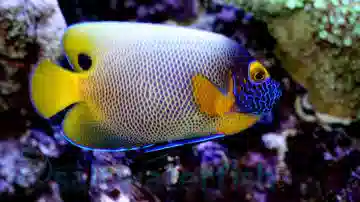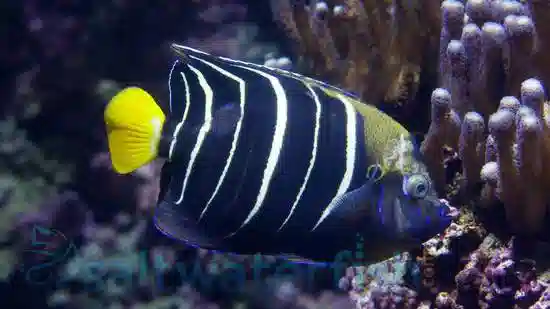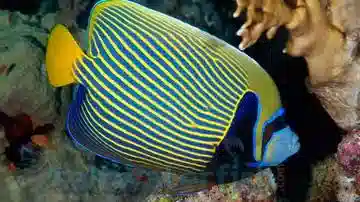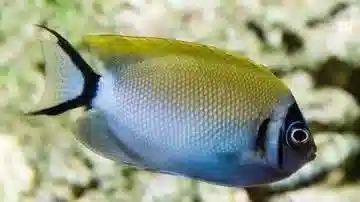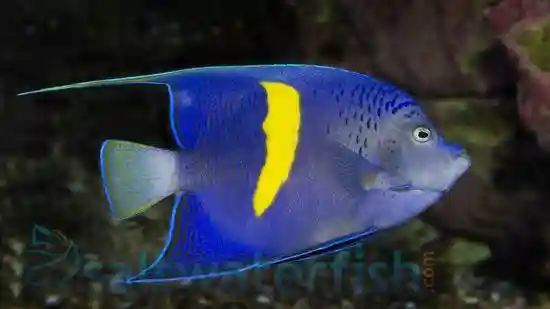Maculosus Angelfish
Pomacanthus maculosus cf.
(0 Reviews)
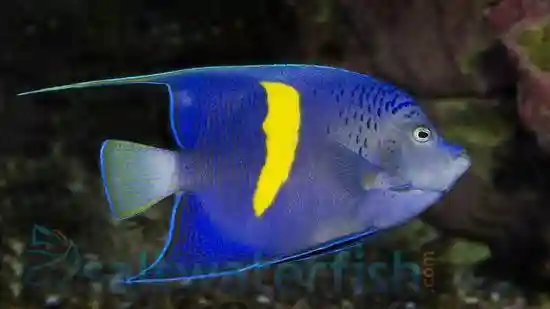
Maculosus Angelfish
Pomacanthus maculosus cf.
(0 Reviews)
{{ item.name }}
Size: {{ item.extra_field_3 }}
${{ getFormattedPrice(item.saleprice) }} ${{ getFormattedPrice(item.price) }}
To join the waiting list, click here
Free Shipping
With
$199.00
or more in Marine Life.
More details...
Maculosus Angelfish Care Facts
| Care Level: | Easy |
|---|---|
| Temperament: | Semi-Aggressive |
| Diet: | Omnivore |
| Origin: | Taiwan |
| Acclimation Time: | 3+ hours |
| Reef Safe: | Monitor |
| Minimum Tank Size: | 250 gallon |
| Maximum Size: | 12 inches |
Maculosus Angelfish (Pomacanthus maculosus) has many common names, including the Yellowbar Angelfish, Yellow-Band Angelfish, Map Angelfish and Blue Moon Angelfish. Adults are solid blue in color with a single yellow stripe going vertically down their body. Their caudal fins can be white or light blue, and some may have dark speckles around their face. Juveniles are dark blue/black with white or and blue vertical lines. They are prone to nipping at corals, so it is recommended to keep them in a FOWLR system with fish of similar size and temperament. Only house one P. maculosus per aquarium. They should be fed a mixture of meaty foods, algae and sponges.
Maculosus Angelfish (Pomacanthus maculosus): A Majestic Addition to Your Marine Aquarium
The Maculosus Angelfish, scientifically known as Pomacanthus maculosus, is a striking marine species sought after by aquarium enthusiasts for its captivating appearance and charming demeanor. In this comprehensive guide, we will delve into the essential aspects of caring for the Maculosus Angelfish in your saltwater aquarium, shedding light on its habitat, suitability for reef tanks, size, lifespan, diet, availability, compatibility with tankmates, sexual dimorphism, juvenile-to-adult coloration changes, temperament, tank requirements, water conditions, common names, and reasons why you should consider adding this species to your collection.
Habitat and Natural Range of the Maculosus Angelfish
The Maculosus Angelfish inhabits the Indo-Pacific region, showcasing its vibrant colors amidst the coral reefs and rocky outcrops. Its native range spans from the eastern coast of Africa, extending across the Indian Ocean to the western Pacific Ocean. In the wild, it is commonly found at depths ranging from 3 to 30 meters.
Reef Compatibility of the Maculosus Angelfish
One of the critical considerations for any saltwater aquarist is whether a species is reef-safe. The Maculosus Angelfish, while a stunning addition to a marine aquarium, may not be the best choice for a reef tank. These angelfish are known to nip at certain types of sessile invertebrates, including corals and some types of sponges. Therefore, if you have a well-established reef tank, you should exercise caution when considering this species.
Size and Lifespan of the Maculosus Angelfish
The Maculosus Angelfish boasts an impressive size, making it a centerpiece fish in larger aquariums. Juveniles start at around 3 to 4 inches (7.5 to 10 cm) and grow to an adult size of approximately 14 inches (35 cm). They can live for an extended period with proper care, often surpassing 15 years in captivity.
Diet in Captivity for the Maculosus Angelfish
In the wild, Maculosus Angelfish primarily feeds on a diet consisting of sponges, tunicates, and various forms of benthic invertebrates. When kept in captivity, replicating this diet is essential for their health. Please provide them with a well-balanced diet, including high-quality marine pellets, frozen or live foods such as brine shrimp, mysis shrimp, and occasional sponge-based foods. Offering a diverse diet will ensure your Maculosus Angelfish receives the essential nutrients it needs to thrive.
Aquaculture and Availability of the Maculosus Angelfish
Aquacultured Maculosus Angelfish are becoming available to hobbyists. These specimens are bred in captivity, making them hardier and less prone to diseases than their wild-caught counterparts. Purchasing aquacultured fish is not only environmentally responsible but also contributes to the overall health and sustainability of the hobby. Absent aquacultured specimens, look for responsibly collected wild-caught specimens.
Compatibility with Other Fish and Invertebrates for the Maculosus Angelfish
The Maculosus Angelfish, despite its territorial tendencies, can coexist with various tankmates when introduced thoughtfully. However, choosing companions that can withstand its sometimes aggressive behavior is crucial. Tangs, surgeonfish, and larger peaceful angelfish are generally good options. Avoid housing them with similarly shaped angelfish, as territorial disputes can arise.
Sexual Dimorphism of the Maculosus Angelfish
The sexual dimorphism in the Maculosus Angelfish is not visually apparent, as males and females exhibit similar external characteristics. To determine the sex of these angelfish, a close examination of their reproductive anatomy is necessary.
Juvenile to Adult Coloration Changes of the Maculosus Angelfish
Juvenile Maculosus Angelfish possess a distinct, eye-catching appearance that evolves as they mature. They display a striking contrast of alternating dark and light vertical bars on their body. However, as they transition into adulthood, these bars gradually transform into a beautiful marbled pattern of blues and yellows, creating a unique and mesmerizing aesthetic.
Temperament of the Maculosus Angelfish
The Maculosus Angelfish is known for its engaging temperament, often becoming a favorite among aquarists due to its interactive nature. They are generally curious and can develop a bond with their caregivers over time. Regular interaction during feeding times can help build trust and a stronger connection with these fish.
Tank Requirements for the Maculosus Angelfish
Providing the right environment for your Maculosus Angelfish is crucial for health and well-being. Here are the critical tank requirements to ensure a thriving aquatic habitat:
- Minimum Aquarium Size: Due to their size and swimming habits, a tank with a capacity of at least 250 gallons is recommended for a single Maculosus Angelfish. Larger tanks are even better as they offer more space for swimming and exploration.
- Aquascaping: Create a habitat that mimics their natural surroundings with plenty of live rock formations, caves, and hiding spots. Provide ample open swimming space as well.
Detailed Water Conditions for the Maculosus Angelfish
- pH: Maintain a stable pH of 8.1 to 8.4 to ensure proper metabolic function and overall well-being.
- Salinity: Keep salinity levels between 1.020 and 1.025, replicating the conditions in their native habitat.
- Water Temperature: Maintain a water temperature between 74°F and 78°F (23°C to 26°C) to ensure your angelfish remains comfortable and disease-free.
- Water Flow: Provide moderate to strong water flow to mimic their natural habitat and help maintain water quality.
Common Names for the Maculosus Angelfish
Apart from the Maculosus Angelfish, this species may also be known by common names such as:
- Yellowbar Angelfish
- Yellow-banded Angelfish
Compatible Tank Mates for the Maculosus Angelfish
When choosing tankmates for your Maculosus Angelfish, consider these compatible species:
- Naso Tang (Naso lituratus): These tangs are peaceful and can coexist with the Maculosus Angelfish.
- Emperor Angelfish (Pomacanthus imperator): Larger angelfish like the Emperor Angelfish can share a tank with the Maculosus, provided there's enough space.
- Yellow Tang (Zebrasoma flavescens): These tangs are known for their peaceful nature and vibrant coloration.
- Foxface Rabbitfish (Siganus vulpinus): These herbivores are generally peaceful and can make good tankmates.
- Powder Blue Tang (Acanthurus leucosternon): Although they can be territorial, they can coexist if introduced carefully and in a sufficiently large tank.
Why People Should Buy the Maculosus Angelfish from Saltwaterfish.com
Choosing Saltwaterfish.com as your source for the Maculosus Angelfish ensures you receive a healthy, carefully sourced, and properly quarantined specimen. Our commitment to responsible aquaculture practices and sustainable sourcing means you're getting a beautiful addition to your aquarium and supporting the long-term health of marine ecosystems. The Maculosus Angelfish is an excellent choice for experienced aquarists looking to add a touch of elegance and personality to their saltwater aquarium.
In conclusion, the Maculosus Angelfish, with its captivating coloration and engaging personality, is a remarkable species to consider for your marine aquarium. By meeting its specific care requirements and providing suitable tankmates, you can enjoy the presence of this majestic fish for many years to come. The beauty and allure of the Maculosus Angelfish will elevate your journey into the world of marine aquaria.
Currently Maculosus Angelfish does not have any reviews.


